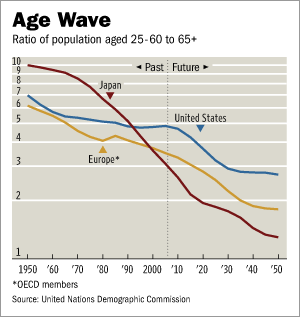Due the reversal of this “century-long trend,” Jeremy Siegel argues in today’s Wall Street Journal that asset prices will remain depressed and bull market trend toward earlier retirement may be “halted dead in its tracks.” He’s probably right, but because not because “demography is destiny.” To understand the real reason behind the emergence of a negative academic perspective on the financial effects of baby boomer retirement accounts, we have to go back to the glory days of the bull market when the very same phrase was being used to assert that stocks were locked in a long-term uptrend. In March 1998 after two separate Barron’s articles discussed the bullish implications of baby boomers’ approaching golden years, here’s what The Elliott Wave Theorist had to say:
In January, a Barron’s headline boldly claimed: “Demography Is Destiny.” We were regaled yet again with the argument that stocks will continue higher for at least another decade as 9.7 million Americans turn 45 between now and 2008. Paul Montgomery (Universal Economics, Legg Mason Wood Walker, Newport News, VA) responded in a letter to the editor, noting that the $146 billion this segment is expected to bring to the market is nothing compared to the $450 billion the market took away in just one day last fall. Instead of calculating what boomers can do for the stock market, Montgomery concluded, boomers should consider “what the market can do to them.”
Proponents volleyed back with another Barron’s feature (“Triple Play”) on February 16. A long-time advocate of the demographics theory discovered another $25 trillion in inevitable stock market flows. The author’s new study, “The Big Shift Barely Begun,” asserts that the stock market will triple again over the next 15 years simply by assuming that it will rise at a historical growth rate of 8% a year. We point out that if GDP were simultaneously to maintain its comparatively meager historical growth rate of 2.5% a year, it would bring stock market valuation to 500% of GDP. The figure as of September was 125%, 50% higher than the old record set in August 1929. Are we to be concerned with such things? “With an air of satisfaction,” the article notes, “The nice thing about demographics is that you’re not wrong unless there’s a plague.” So to some, the proposed relationship of demographics to the stock market is not a theory but a law of nature: the bull market as manifest destiny. Recent statistics show that baby boomers are not saving much, but they are saving differently. What used to go into the bank or a second home now goes right into the stock market. We think this change in behavior illustrates Montgomery’s point: Investment is based on emotional, not mechanical, decision-making. We think that the demographics theory will ultimately prove to have been a rationalization of an emotional state.
The proof is in the 180-degree switch from an unbridled belief in the positive effects of baby boomer retirements to a likely crisis. To top it off, the argument is being made most prominently by the author of Stock for the Long Run, a book that was one of the definitive bull market treatise on buying and holding stocks in the late 1990s.

He offers as evidence the chart above, which actually shows that the ratio of workers to retirees has been declining across the western world for decades. Why are stocks only now getting into sync on the downside? The reason is that social mood, not demagraphics, controls the valuation of financial assets. The chart in our Socio Times entry of June 6, “The Pig, The Python and The Bear Market,” shows how the course of stocks through the initial phase of the bear market reflects a collective souring on boomer’s pension prospects. The word is that Siegel’s latest book about the potentially catastrophic ramifications of baby boomer retirements is due out in December. If so, it should be perfectly in line to fuel what should be a fiery phase of the bear market. |
